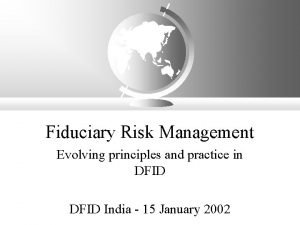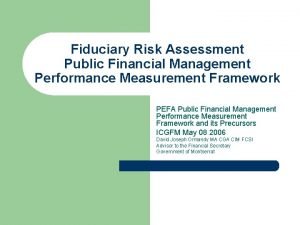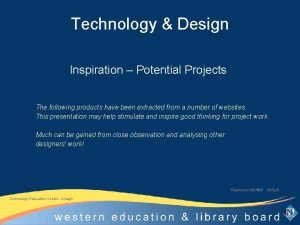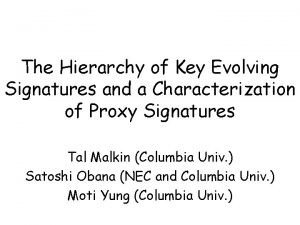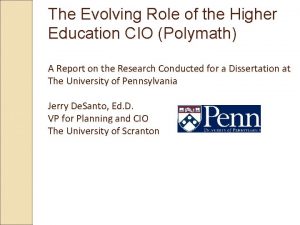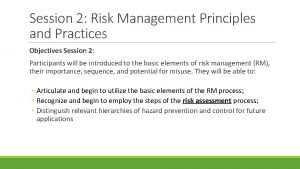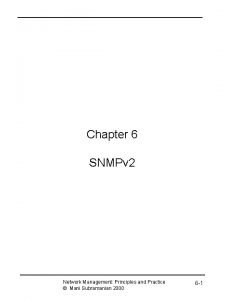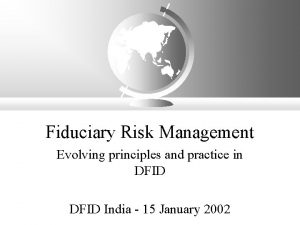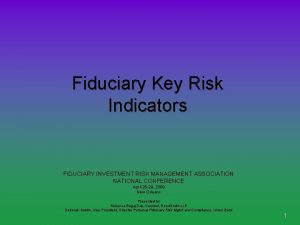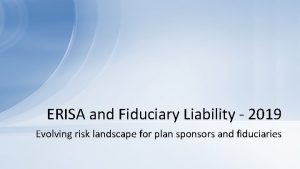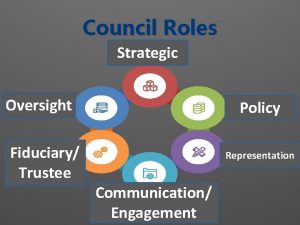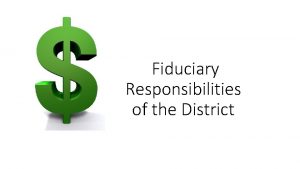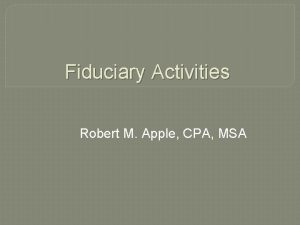Fiduciary Risk Management Evolving principles and practice in











- Slides: 11

Fiduciary Risk Management Evolving principles and practice in DFID India - 15 January 2002

Context F DFID commitment to increase direct budget support, i. e. – Financial support linked to poverty reduction strategy – Reliance on government systems – Long term commitment – National, sub-national or sector budget,

Case for Direct Budget Support F Perceived advantages of DBS – Country driven/owned – Raises level of dialogue to address issues of poverty at policy and strategic level – Vehicle for addressing cross cutting issues such as PSR and PFM – Less distorting of expenditure priorities – Lower transaction costs But what happens to the money?

What is fiduciary risk? F Fiduciary = “position of trust or stewardship over funds” DFID has responsibility for making proper use of the funds voted by Parliament DFID’s Accounting Officer is responsible for ensuring that resources are; – Properly accounted for (Government Accounting Rules) – Used only to the extent and for the purposes authorised (i. e. as set out in the Overseas Development Act and the budget) – Achieve economy efficiency and effectiveness (i. e. value for money) F Fiduciary risk is the risk that these objectives will not be met

Why is management of fiduciary risk an issue? F F F DFID is putting more of its resources through other governments PEM systems DBS linked to pro poor budget and service delivery rather than economic policy reforms (programme aid) Need to demonstrate that direct budget support is an effective form of aid (external audiences) Risk to DFID’s reputation HIPC has led to international focus (esp. US and Japan) on perceived risks of direct budget support

A key governance issue F F F Sound management of public finances are intrinsically important to development Transparency about how public resources are raised and then used is basic to democratic accountability Improvements can lead to big changes which benefit the poor (viz Uganda education) Off budget expenditure financed by donors undermines accountability Active scrutiny by legislature and public is essential

Should we be worried? F Evidence shows that these systems are in very poor shape in many of our partner countries F Assessment of accounting in countries receiving direct budget support from DFID – No country met the proposed minimum standard F IMF/WB review of HIPC countries – Little upgrading = 2 – Significant upgrade = 6 – Substantial upgrade = 14

What’s wrong with the old approach to fiduciary risk? Notional funding of specific areas of government spending, e. g teachers salaries - ignores fungibility F Audit of expenditure items equivalent in value to DFID funds - tells us nothing about impact F Main focus on allocations in the budget, not on where money ends up F Few links between the state of financial management and accountability and programme design/conditionality F

A new approach - I F F Aim to improve Government systems so we can rely on them to make effective use of all resources, including DFID funds. Willing to take risks by putting money through government systems, provided: – risks are known and outweighed by benefits – Government has a credible programme to improve PFMA – Safeguards can be put in place to address key weaknesses F Key risk areas; – Accounting (where has the money gone? ) – Procurement (corruption and VFM)

A new approach - II Building PEM improvement into the PRS and monitoring frameworks for PRSC/PRGF F Long term technical and financial support to improve systems F Incentives (+ and -) for governments to improve their effectiveness and accountability F Work with others who share our agenda (Go. I, WB etc. ) F

Relevance to India Moving towards poverty reduction strategies in partner states F SWAP approaches developing in some sectors F Financial problems in state budgets undermine PRS F Short term focus on fiscal sustainability F Long term potential through focus on F – – Efficiency and effectiveness of public sector Transparency Accountability Probity
 Fiduciary risk assessment
Fiduciary risk assessment Key risk indicators template
Key risk indicators template Fiduciary investment risk management association
Fiduciary investment risk management association Fiduciary risk assessment
Fiduciary risk assessment Liquidity measures
Liquidity measures Evolving design
Evolving design A framework for clustering evolving data streams
A framework for clustering evolving data streams Key evolving signature
Key evolving signature Evolving
Evolving Risk management principles and practices
Risk management principles and practices Network management principles
Network management principles Network management principles
Network management principles
